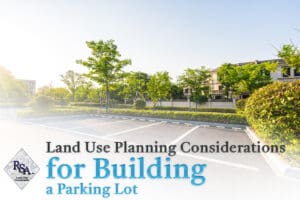 Parking lots may seem like a straightforward component of commercial development, but they are a crucial aspect of land use planning, especially in regions like Southern Oregon, where land values, environmental considerations, and transportation infrastructure play significant roles in shaping communities. At Richard Stevens and Associates, we understand that effective land use planning for building a parking lot is essential for compliance with local and state regulations and ensuring long-term functionality, environmental stewardship, and community acceptance.
Parking lots may seem like a straightforward component of commercial development, but they are a crucial aspect of land use planning, especially in regions like Southern Oregon, where land values, environmental considerations, and transportation infrastructure play significant roles in shaping communities. At Richard Stevens and Associates, we understand that effective land use planning for building a parking lot is essential for compliance with local and state regulations and ensuring long-term functionality, environmental stewardship, and community acceptance.
What You Need to Know For Building a Parking Lot:
1. Zoning and Code Compliance
In Southern Oregon, local zoning ordinances dictate the minimum and maximum number of parking spaces, setback requirements, lighting, landscaping, and more. Jurisdictions like Jackson and Josephine Counties, along with cities such as Medford, Grants Pass, and Ashland, each have unique zoning codes that must be followed. For example, commercial and mixed-use zones may have different parking ratio requirements than residential or industrial zones.
Key zoning considerations include:
- Minimum and maximum space requirements per square foot of building area or per dwelling unit.
- Location regulations may require parking to be behind or beside buildings in walkable districts.
- Accessible parking compliance with the Americans with Disabilities Act (ADA).
- Shared parking allowances for developments with varying peak-use times.
Failure to comply can result in project delays, denied permits, or costly redesigns. A thorough code review early in the process ensures smoother permitting and approval.
2. Environmental Impact and Stormwater Management
Parking lots can significantly impact the environment through increased impervious surfaces, which contribute to stormwater runoff and reduce groundwater recharge. In Southern Oregon, which features a mix of urban and rural landscapes and environmentally sensitive areas, land use planners must address environmental concerns proactively.
Considerations include:
- Stormwater detention and retention: Parking lots must be designed with on-site facilities like bioswales, detention ponds, or underground systems to control runoff.
- Low-Impact Development (LID) techniques: These include permeable pavement, green infrastructure, and rain gardens that reduce environmental impacts while improving aesthetics.
- Runoff filtration: Oil separators and filters may be required before discharging runoff into municipal systems or natural waterways.
Local agencies such as the Rogue Valley Sewer Services (RVSS) and the Oregon Department of Environmental Quality (DEQ) may require environmental permits or stormwater management plans.
3. Traffic Flow and Connectivity
Parking lot design should prioritize efficient vehicle movement and pedestrian safety. In regions like Southern Oregon, where developments range from urban shopping centers to rural medical clinics, ensuring safe ingress and egress is critical.
Important planning features include:
- Driveway spacing and access management: Many jurisdictions limit the number of access points on major roadways to reduce traffic congestion and minimize accidents.
- Internal circulation patterns: Good design minimizes conflicts between vehicles and pedestrians and provides logical connections to entrances and exits.
- Pedestrian and bike access: Integrating walkways, bike racks, and clear signage supports multimodal transportation and encourages walkability.
Working with a traffic engineer and city planner can help optimize design for both safety and functionality.
4. Aesthetic and Community Design Standards
Community character and urban design standards play an increasingly important role in building a parking lot. Southern Oregon municipalities often have design guidelines intended to reduce parking lots’ visual dominance, particularly in downtown districts, tourism zones, and historic neighborhoods.
Typical requirements may include:
- Landscaping buffers around the perimeter of lots and between parking rows.
- Screening or fencing adjacent to residential zones or scenic corridors.
- Lighting design that minimizes light pollution while enhancing security.
- Green space integration, such as tree islands, to reduce heat islands and improve visual appeal.
These features enhance the value of developments, contribute to livability, and help projects gain community support during the public review process.
5. Sustainability and Future Flexibility
With changing transportation trends, land use planners should consider future-proofing parking lots to accommodate shifts in demand and support sustainable development goals. Southern Oregon’s growing interest in green infrastructure and climate-conscious planning makes this a timely topic.
Forward-looking strategies include:
- Electric vehicle (EV) charging stations: Installing or pre-wiring for EV chargers can meet rising consumer expectations and satisfy green building incentives.
- Solar canopies: Providing solar panel infrastructure over parking areas produces energy and may qualify for tax credits.
- Shared-use strategies: Mixed-use developments can optimize parking space efficiency through shared arrangements and valet systems.
- Redevelopment potential: Designing parking lots with the potential for conversion to buildings or other uses ensures flexibility as land values rise or transit options improve.
Richard Stevens and Associates helps clients plan with a long-term view, balancing present needs with future opportunities.
6. Permitting and Public Involvement
In Southern Oregon, building a parking lot often requires coordination with multiple public agencies, including city planning departments, state transportation departments (e.g., ODOT), and regional planning bodies. The permitting process may involve:
- Site plan review
- Land use application
- Environmental assessments
- Public hearings
Community engagement is critical. Projects that involve large surface parking lots, particularly in commercial or transitional neighborhoods, may face public scrutiny regarding traffic, environmental concerns, or aesthetics. Proactive outreach and transparent communication can streamline approval and avoid delays.
Getting Ready to Build a Parking Lot? Contact Us First!
Parking lots are more than utilitarian spaces—they are integral components of a community’s form, function, and environmental health. In Southern Oregon, successful parking lot planning and development requires a careful balance of regulatory compliance, environmental sensitivity, transportation functionality, and community aesthetics.
Richard Stevens and Associates brings decades of experience in land use planning, permitting, and development consulting across Southern Oregon. Whether you’re a commercial developer, public agency, or private landowner, our team can guide you through the complexities of building a parking lot, ensuring that your project is designed thoughtfully, built sustainably, and aligned with community goals. To learn more about our services or schedule a consultation, visit rsaoregon.com.
